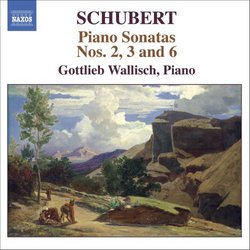| All Artists: Franz [Vienna] Schubert, Gottlieb Wallisch Title: Schubert: Piano Sonatas Nos. 2, 3 & 6 Members Wishing: 0 Total Copies: 0 Label: Naxos Original Release Date: 1/1/2006 Re-Release Date: 3/21/2006 Genre: Classical Styles: Chamber Music, Forms & Genres, Sonatas, Historical Periods, Classical (c.1770-1830), Romantic (c.1820-1910) Number of Discs: 1 SwapaCD Credits: 1 UPC: 747313263929 |
Search - Franz [Vienna] Schubert, Gottlieb Wallisch :: Schubert: Piano Sonatas Nos. 2, 3 & 6
 | Franz [Vienna] Schubert, Gottlieb Wallisch Schubert: Piano Sonatas Nos. 2, 3 & 6 Genre: Classical
|
Larger Image |
CD Details |
CD ReviewsEarliest Schubert Piano Sonatas J Scott Morrison | Middlebury VT, USA | 04/10/2006 (4 out of 5 stars) "This CD of early Schubert piano sonatas -- Nos. 2, 3 & 6 -- played by pianist Gottlieb Wallisch, a young Austrian artist, is a companion to his earlier CD containing other early Schubert sonatas -- Nos. 5, 7a, 11 & 12. I think this current disc is marginally less satisfying than the first one largely because Schubert, who wrote the sonatas when he was in his teens, was less sure of himself, less the master of his materials. There are some awkward transitions and modulations, some gawky rhythmic figures. Yet there are some striking passages as well, some of them echt Schubert as we came to know him. The first movement of No. 2 tries (and fails slightly) to imitate a weighty Beethovenian sonata movement. Still, it has some interesting contrapuntal passages and memorable melodies. There is no extant finale for the sonata; an allegretto from the same period is placed in fourth-movement position. Unfortunately it is unfinished and breaks off suddenly after 200+ measures.
Sonata No. 3 is in five movements -- obviously an experiment on Schubert's part -- and was originally published as 'Five Piano Pieces' although the work was clearly intended as a sonata; it is speculated that Schubert's publisher thought sales would benefit from the 'piano pieces' designation. The second movement is called a 'scherzo' but it is actually a rather conventional sonata-allegro movement. The adagio is a lovely, serene meditation (as is the andante of the Second Sonata). Wallfisch, in his helpful booklet notes, comments that Schubert's writing for the piano at this stage of his development was unwieldy. This is particularly noticeable in the Third Sonata's third movement, a true Scherzo con Trio. The most satisfying of the three sonatas presented here is No. 6 (D. 566/506). In it we have the most Schubertian music yet. The second movement is particularly charming. (The fourth movement is possibly missing and in this recording D. 506, a marvelous rondo, is played.) We have, in the last fifty years, come to regard Schubert's piano music as some of his best. Even so, these early works are not at all well known. It is helpful to hear these works and follow Schubert's development. This CD, then, is recommended for those who are curious about this aspect of Schubert's music. The works are given excellent performances here by Herr Wallisch. Recorded sound is fine. Scott Morrison" |

 Track Listings (13) - Disc #1
Track Listings (13) - Disc #1